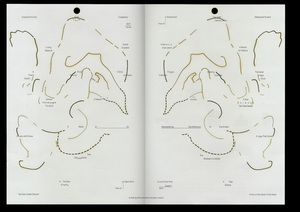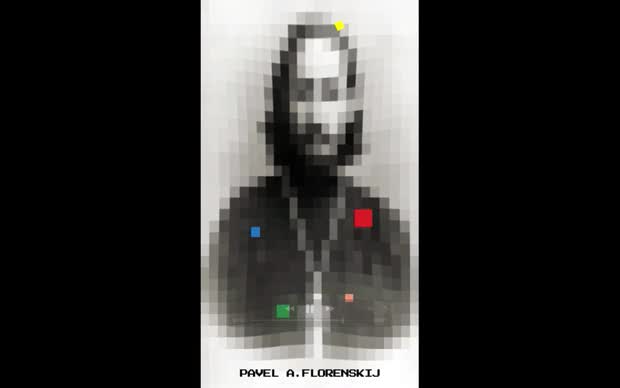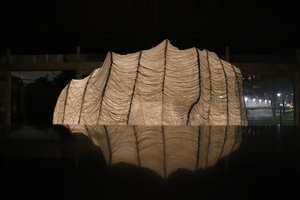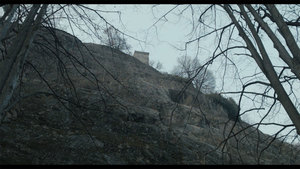'all the good girls go to hell' – Zur Widerständigkeit in der Figur der Hexe
Benachbarte Sets (16)Alle Zusammenhänge anzeigen
Diese Sets wurden den gleichen Sets hinzugefügt wie das ausgewählte Set.
16 Inhalte
- Seite 1 von 2
I Cried A Smile
- Titel
- I Cried A Smile
- Autor/in
- Beschreibung (de)
- Mit den Mitteln einer wissenschaftlichen Lecture erzählt „I Cried A Smile“ eine Geschichte über eine Person mit 2 Köpfen, Holz das zu Menschen wird, und die Erinnerung daran als Kind mit Neuropsychologie in Kontakt zu treten. Zwei übereinander hängende Projektionsflächen zeigen Zeichnungen, Animationen und gefundenes Bildmaterial während meine Stimme vom Band läuft und ich an einem Schreibtisch sitzend, mit dem Verfahren „Lip-Sync“ lautlos mitspreche. Das Publikum sitzt wie in einem anatomischen Theater in zwei Halbkreisen um mich herum.
- Beschreibung (en)
- Using the means of a scientific lecture, “I Cried A Smile” tells a story about a person with two heads, wood that becomes human, and the memory of coming into contact with neuropsychology as a child. Two projection screens hanging above me showcasing drawings, animations and found footage while my voice runs from the tape and I, sitting at a desk, speak along inaudibly using the “Lip-Sync” method. The audience sits around me like in an anatomical theater.
- Using the means of a scientific lecture, “I Cried A Smile” tells a story about a person with two heads, wood that becomes human, and the memory of coming into contact with neuropsychology as a child. Two projection screens hanging above me showcasing drawings, animations and found footage while my voice runs from the tape and I, sitting at a desk, speak along inaudibly using the “Lip-Sync” method. The audience sits around me like in an anatomical theater.
- Kategorie
- Typ des Projekts/Werks
- Schlagworte
- Mitwirkende
- Technik/Verfahren/Formate
- 2 Channel Video
- Dauer
- 8 Minuten
- Ort: Institution
- Stadt
- Land
- Titel
- I Cried A Smile
- Importiert am
- 30.09.2024
- Übergeordnete Sets
- 0
- Set enthält
- 0 5
G.O.T.T.A.L.I.S.T.E.N.
- Titel
- G.O.T.T.A.L.I.S.T.E.N.
- Autor/in
- Beschreibung (de)
- "GOTTALISTEN", kurz für „Grab One Terrene Thought And Let It Slide To Eternal Nothingness”, beschäftigt sich mit der Zeit der Oktoberrevolution in Russland im Jahr 1917. Die Klebeband-Leinwände nehmen Bezug auf den Künstler Kasimir Malewitsch, der während dieser Epoche in Russland lebte. Zudem setzt Claus sich mit dem russischen Religionsphilosoph, Priester, Mathematiker und Kunstwissenschaftler Pavel Florenskij auseinander.
- Beschreibung (en)
- "GOTTALISTEN", short for "Grab One Terrene Thought And Let It Slide To Eternal Nothingness", deals with the time of the October Revolution in Russia in 1917. The tape canvases refer to the artist Kasimir Malewitsch, who lived in Russia during this era. Claus also deals with the Russian religious philosopher, priest, mathematician and art historian Pavel Florenskij.
- Kategorie
- Schlagworte
- Titel
- G.O.T.T.A.L.I.S.T.E.N.
- Projektleiter/in
- Semester
- Studiengang
- Typ der Abschlussarbeit
- Importiert am
- 08.08.2024
- Übergeordnete Sets
- 0
- Set enthält
- 1 27
ETWAS BLEIBT
- Titel
- ETWAS BLEIBT
- Titel (en)
- WHAT REMAINS
- Autor/in
- Beschreibung (de)
- Etwas bleibt ist ein Portrait über einen Flecken Erde.
Etwas bleibt ist der Klang dieser Landschaft.
Etwas bleibt ist die Erzählung einer Geschichte.
Elenya Bannert beschäftigt sich in ihrer filmischen Erzählung mit dem Alter, dem Vergessen, den Anforderungen unserer heutigen Zeit und einem Leben, das so nur noch selten zu finden ist.
Matteo ist alt, er lebt alleine auf einer Alm. Er ist jedoch nicht ganz alleine: Seine Kuh erinnert ihn von Zeit zu Zeit daran, gemolken werden zu wollen. Das Lesen fällt ihm schwer und auch sonst wird Matteo ein wenig vergesslich und wunderlich.
Die finalen Dreharbeiten zu dem Film begannen im März 2017. Das idyllische Dorf Soglio, im Kanton Graubünden / Schweiz, dient als Schauplatz für die Geschichte.
Um mit Bild, Ton und Narration gleichwertig umgehen zu können, verzichtet dieser Film konsequent auf schauspielerische Leistung und erzählt aus der Sicht der Tochter, wodurch der narrative Charakter der Geschichte stark in den Vordergrund tritt.
Das filmische Material, das entstanden ist, wirkt auf stimmungsvolle Weise dokumentarisch und unterstützt den Betrachter darin, sich mit seiner individuellen Phantasie auseinanderzusetzen.
- Etwas bleibt ist ein Portrait über einen Flecken Erde.
- Beschreibung (en)
- What remains is a portrait of a spot of earth.
What remains is the sound of the landscape.
What remains is the telling of a story.
In her cinematic narrative, Elenya Bannert deals with the concepts of age, forgetting, the demands of our current times, and a life that is nowadays so hard to come by.
Matteo is old, and lives alone on an Alpine pasture. He is, however, not completely alone; his cow reminds him from time to time that she needs milking. Reading has become difficult for Matteo, and he has also become a little forgetful and peculiar.
The final film shoot began in March 2017. The idyllic village of Soglio in the canton of Graubünden / Schweiz serves as the backdrop for the story.
In order to be able to deal with image, sound and narration equally, the film consequently rejects acting, and the story is told through the eyes of the daughter, bringing the narrative character of the story distinctly to the fore.
The emerging cinematic material appears documentary in an atmospheric way and encourages the viewer to confront individual phantasies.
- What remains is a portrait of a spot of earth.
- Typ des Projekts/Werks
- Datierung
- 2017
- Mitwirkende
- Sprache
- Material
- Dauer
- 10 min
- Bemerkungen
- Buch & Regie: Elenya Bannert
Kamera: Tilmann Rödiger
Sounddesign: Max Lange
Musik: Kalkhofer
- Buch & Regie: Elenya Bannert
- Titel
- ETWAS BLEIBT
- Projektleiter/in
- Semester
- Importiert am
- 20.07.2018
- Übergeordnete Sets
- 0
- Set enthält
- 0 6



